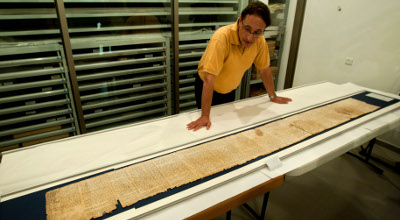Digital Technology Brings New Life to Dead Sea Scrolls
For decades after they were discovered in a cave, the Dead Sea Scrolls were allowed to be examined closely only by fewer than a couple dozen scholars and archaeologists.
Now, with infrared- and computer-enhanced photography, anyone with a computer can view these 2,000-year-old relics, which include the oldest known copies of biblical text and a window on the world and times of Jesus.
High-quality digitized images of five of the 950 manuscripts were posted for free online for the first time this week by Google and the Israel Museum in Jerusalem, where the scrolls are housed. The post includes an English translation and a search feature to one of the texts, the Great Isaiah Scroll.
The scroll, one of seven animal skin parchments discovered in 1947 in a cave in Wadi Qumran in the West Bank, is the largest and best preserved.
“Some of these images are appearing for the first time in Google — what no one has seen for 2,000 years and no scholar since the Dead Sea Scrolls were found,” says James Charlesworth, director and editor of the Princeton Dead Sea Scrolls Project, who is one of the few who has handled the ancient pieces of parchment. “Now images and letters that were never found are appearing in Google.”
Charlesworth said the new images allow him to decipher in 30 minutes fragments of documents that once took 14 hours to analyze. The digital project will preserve documents that were eaten by worms and so fragile they’re turning to dust or rotting away.
Read the rest of this article in USA Today.
Watch a Google video on the Dead Sea Scrolls below.














































